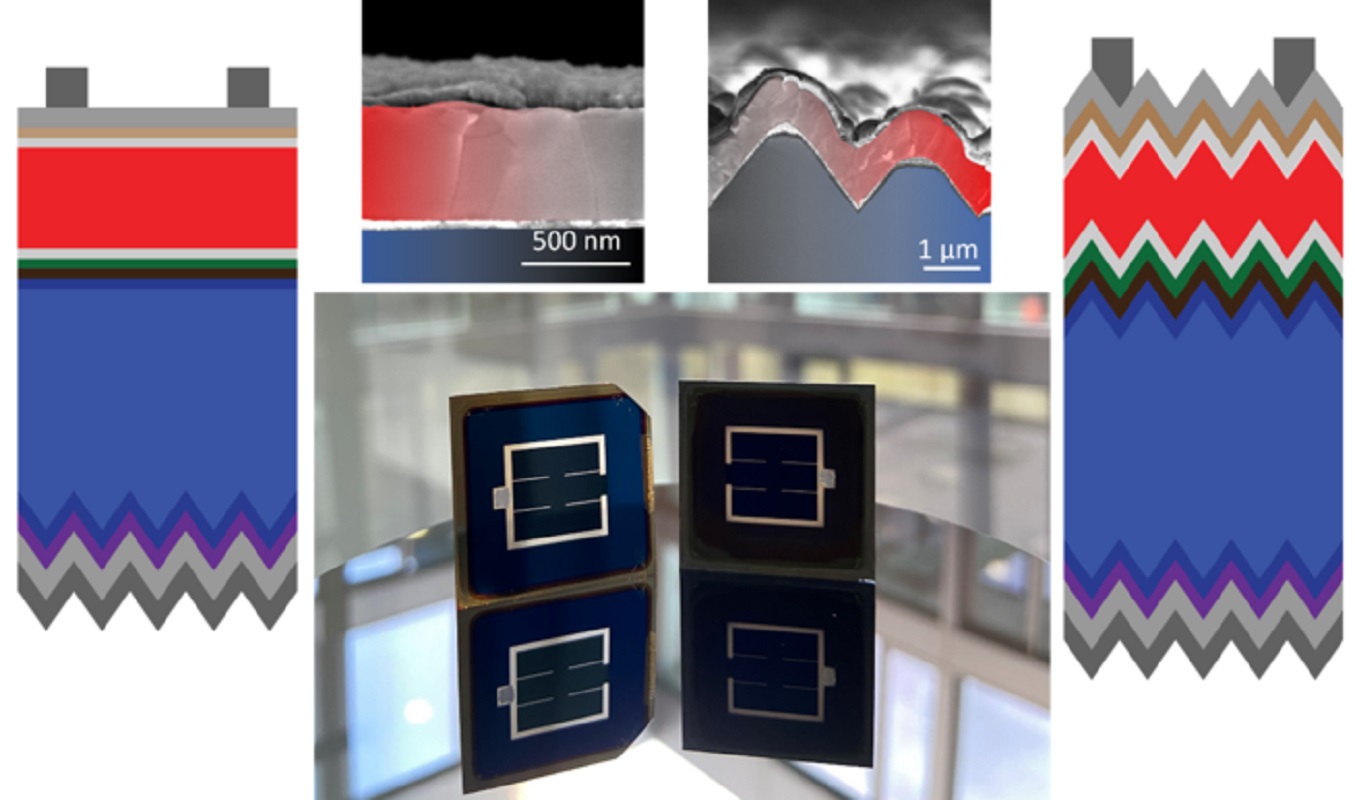Author:
Ally Winning, European Editor, PSD
Date
07/12/2022

Left and right panels: Schematics of perovskite-on-silicon tandems that are either flat or textured on their front side. Upper central panels: scanning electron microscopy images of the two types of devices developed by EPFL and CSEM. Lower central panels: corresponding picture.
As we are relying more on renewables, getting the maximum energy possible out of their generation is important. The higher the efficiency, the lower the overall cost of the generated electricity over the lifetime of the installation. Furthermore, higher efficiency means the same amount of energy can be extracted from a smaller generator. For solar power, that means that smaller panels can be fitted in more diverse locations and allow new applications. For example, self powered drones. However, to increase the efficiency of solar panels will require new technology. Currently, the main material used in solar panels is silicon, which has a maximum theoretical efficiency off 29%. At the moment, modern solar panels operate around 27% efficiency, which means that there is very little room for improvement.
Scientists have been recently trying to improve the efficiency of solar energy by combining silicon with complementary solar cells to form tandem solar cells. These cells work by extracting the higher-energy visible light of the sun in the top cell, and the lower-energy infrared light in the silicon cell at the rear of the tandem. The most promising of these types of complementary solar cells is made from halide perovskites, which converts visible light more efficiently to electrical power than silicon alone. This combination is made without significantly increasing fabrication costs. Perovskites are the class of compounds which have the same type of crystal structure as calcium titanium oxide.
Researchers from Neuchâtel have recently improved the efficiency of two different types of perovskite-on-silicon tandems to provide the highest efficiency yet achieved by this type of structure. Initially, they adapted materials and fabrication techniques to deposit high-quality perovskite layers from solution on a planarized silicon surface, reaching a power conversion efficiency of 30.93% for a 1 cm2 solar cell. Then, they worked on a new version of a hybrid vapor/solution processing technique compatible with textured silicon surfaces, and produced a solar cell with a power conversion efficiency of 31.25% on a 1 cm2 cell. The results confirmed that both trials achieved world record conversions. The second approach provides a higher current and is compatible with the structure of current industrial silicon solar cells. The previous efficiency conversion record for perovskite-on-silicon tandem solar cells was set in 2021 by a team at the Helmholtz Zentrum Berlin, who achieved 29.8%. The new records were independently certified by the National Renewable Energy Laboratory (NREL) in the United States.
Christophe Ballif, Head of the EPFL Photovoltaics Laboratory and CSEM’s Sustainable Energy Center said, “We have validated experimentally the high-efficiency potential of perovskite-on-silicon tandems. The 30% efficiency mark had already been achieved with III-V semiconductors. However, these materials and the processes used to make them are too expensive to sustain the energy transition – these devices are a thousand times more expensive than silicon solar cells. Our results are the first to show that the 30% barrier can be overcome using low-cost materials and processes, which should open new perspectives for the future of PV.”
The research was driven by the EPFL PV-lab team in Neuchâtel (Dr. Xin Yu Chin, Deniz Türkay, Kerem Artuk, Dr. Mathieu Boccard, and colleagues of the Tandem Photovoltaics team led by Dr. Christian Wolff), working in association with scientists at CSEM (Dr. Brett Kamino, Dr. Florent Sahli, Dr. Soo-Jin Moon, Arnaud Walter, and colleagues, led by Dr. Quentin Jeangros). It has received funding from the Swiss Federal Office of Energy, the Swiss National Science Foundation, the European Commission, the Services Industriels de Genève, and the Advanced Manufacturing Initiative of the ETH domain.